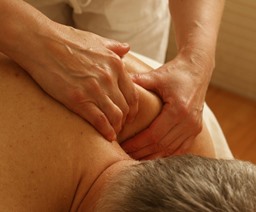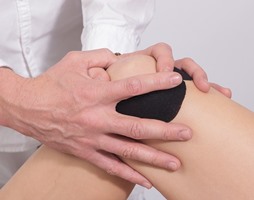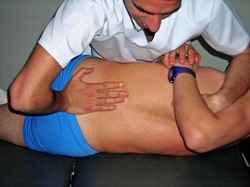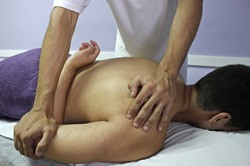How to Choose the Best Massage Therapist School near Stanford Montana
 Choosing the best massage therapy school near Stanford MT is an important first step toward launching a fulfilling new career as a massage therapist. As you have no doubt concluded, who wouldn’t want to work in an occupation where the sole purpose is to help people function and feel better? Massage therapists can work in a wide variety of locations, including hospitals, day spas, health clubs and even aboard cruise ships! However prior to beginning a career in this specialty of holistic healthcare, obtaining the proper training and licensing is a must. And keep in mind that not all massage therapy programs are the same. When evaluating your options, it’s important that you look at all aspects of the schools you are reviewing and not make your decision based solely on location or cost of tuition. Following are a few fundamental tips that you need to include in your review process when choosing a massage therapy school.
Choosing the best massage therapy school near Stanford MT is an important first step toward launching a fulfilling new career as a massage therapist. As you have no doubt concluded, who wouldn’t want to work in an occupation where the sole purpose is to help people function and feel better? Massage therapists can work in a wide variety of locations, including hospitals, day spas, health clubs and even aboard cruise ships! However prior to beginning a career in this specialty of holistic healthcare, obtaining the proper training and licensing is a must. And keep in mind that not all massage therapy programs are the same. When evaluating your options, it’s important that you look at all aspects of the schools you are reviewing and not make your decision based solely on location or cost of tuition. Following are a few fundamental tips that you need to include in your review process when choosing a massage therapy school.
What is a Massage Therapist?
 As mentioned in the introduction, massage therapy is a holistic form of healthcare in Stanford MT that helps people feel and function better. The massage therapist manipulates skin, muscles and tissue to reduce stress and relieve tension and pain in their patients. Swedish, or Classic Massage, is the type of massage that most people think of when discussing massage therapy, and most massage therapy schools teach it as their primary form of massage. However, there are many other types of massage that programs may or may not include within their course of instruction. Following are just a few examples.
As mentioned in the introduction, massage therapy is a holistic form of healthcare in Stanford MT that helps people feel and function better. The massage therapist manipulates skin, muscles and tissue to reduce stress and relieve tension and pain in their patients. Swedish, or Classic Massage, is the type of massage that most people think of when discussing massage therapy, and most massage therapy schools teach it as their primary form of massage. However, there are many other types of massage that programs may or may not include within their course of instruction. Following are just a few examples.
- Neuromuscular Therapy Massage
- Deep Tissue Massage
- Sports Massage
- Shiatsu Massage
- Thai Massage
- Hot Stone Massage
- Pregnancy Massage
Professionals that work in massage therapy in Stanford MT should be referred to as massage therapists. From time to time one may hear them called a masseuse or a masseur, which refers to a female or a male massage practitioner. However, these terms generally carry a negative connotation among the general public and professionals alike and should be avoided.
Click Here to Get Free Information on Massage Therapy Schools Near You!
Massage Therapist Training Requirements
 Most schools offering massage therapy require that the enrollee have a high school diploma or its equivalent to qualify. Programs can range in length from several months for a Certificate or a Diploma to as long as two years for an Associate’s Degree. The lengths of the programs will also vary by State based on the number of hours required for licensing. Another factor that may also influence the program length is whether classes are offered in Stanford MT during the day or in the evening. Also, an Associate Degree in Massage Therapy may have general education requirements and are often transferable into a related Bachelor’s Degree Program. Once you have received your Certificate or Degree, the education does not end there. The amount and type of continuing education you will need to complete will depend on the State where you are licensed. Some states require both a certain number of hours of continuing education as well as specific education in subjects such as HIPAA compliance or ethics.
Most schools offering massage therapy require that the enrollee have a high school diploma or its equivalent to qualify. Programs can range in length from several months for a Certificate or a Diploma to as long as two years for an Associate’s Degree. The lengths of the programs will also vary by State based on the number of hours required for licensing. Another factor that may also influence the program length is whether classes are offered in Stanford MT during the day or in the evening. Also, an Associate Degree in Massage Therapy may have general education requirements and are often transferable into a related Bachelor’s Degree Program. Once you have received your Certificate or Degree, the education does not end there. The amount and type of continuing education you will need to complete will depend on the State where you are licensed. Some states require both a certain number of hours of continuing education as well as specific education in subjects such as HIPAA compliance or ethics.
Massage Therapist Licensing
Once you have graduated from an accredited massage therapy school, you will then need to become licensed in the State where you will be practicing. The Massage & Bodywork Licensing Examination (MBLEx), is a test controlled and administered by the Federation of State Massage Therapy Boards (FSMTB) and is required by most States as part of the licensing process. Some States have their own or additional exams, so check with your State prior to enrolling in a massage therapy program. If you do not pass the MBLEx in the first attempt, you can take it again after 30 days but must pay an additional exam fee. Once licensed, you will need to maintain it in most states, which means paying a renewal fee and satisfying renewal requirements. As previously mentioned, renewal typically requires a certain number of hours of continuing education be completed. And if you should move to another State, you will need to get licensed in that new State as well. Every State regulates massage therapy differently, so it is not safe to assume that you will automatically qualify for licensing. Check with your new State before moving to confirm that you meet the requirements to legally practice there.
Questions to Ask Massage Therapist Programs
 Before you pick a massage therapist school, there are some important questions that you need to ask about the programs you are considering. As previously mentioned, the location of the school is important, particularly if you will be commuting to classes from Stanford MT. And of course the total cost, including tuition, books and all training materials will also be an important factor. But beyond those basic qualifications, following are some questions you should ask so that you have all of the facts before choosing a massage therapy degree program.
Before you pick a massage therapist school, there are some important questions that you need to ask about the programs you are considering. As previously mentioned, the location of the school is important, particularly if you will be commuting to classes from Stanford MT. And of course the total cost, including tuition, books and all training materials will also be an important factor. But beyond those basic qualifications, following are some questions you should ask so that you have all of the facts before choosing a massage therapy degree program.
- Is the School Accredited? Accreditation may be required for licensing as well as student loans or financial aid. It also helps to ensure that the program meets acceptable levels of quality. Some Stanford MT employers also prefer job candidates from accredited schools.
- Does their Curriculum Comply with EALP Standards? Entry-Level Analysis Project (EALP) standards were created by an association of massage organizations to define minimum standards for preparing massage school graduates for entry-level professional work.
- What Massage Therapy Programs are Available? Find out if the type of program you are interested in is available, such as an Associate Degree in Massage Therapy. Also, if you need to attend evening classes near Stanford MT make sure that they are offered as well.
- What Types of Massage Therapy are Taught? As previously mentioned, most massage therapy schools teach Swedish Massage. However, the better programs include multiple types of massage therapy. Make sure that the program you choose includes those you are most interested in.
- Is Financial Aid Available? To qualify for federal financial aid or a student loan, the school will need to be accredited by a national accrediting organization. Find out from the schools you are considering what they offer in aid or if they assist students in obtaining funding from other sources.
- How Long has the School Existed? One indication that a school provides a quality education is longevity. However, all schools had to start from day one, and many fine schools are relatively new. So use this as one of several qualifications when comparing schools.
- Does the School have a Job Placement Program? Find out if the schools have job placement programs and what their placement rates are. Ask if they assist with such skills as how to interview for a position and how to prepare a resume.
- Is Plenty of Hands-On Training Provided? This includes classroom training as well as placement in internship programs. The best massage therapy schools make sure that students have plenty of time to practice what they learn so they can develop their skills and be corrected when necessary.
- What is the Background of the Faculty? Find out what the experience and credentials are of the teaching faculty. Speaking with schools’ faculty in person can also provide valuable information. Before applying, arrange to take a tour of the school and talk with staff members and students if permissible. Schools may also have Open House events for prospective students.
Massage Therapist Schools Near Me Stanford MT
 Good luck as you embark on your journey to begin a career as a professional massage therapist. As with all things worth achieving, it will take a lot of hard work and dedication to succeed. You originally came to this website because of your interest in Massage Therapist Schools Near Me and wanting to get more information on the topic How To Become A Sports Massage Therapist. However, by following the suggestions contained within this article, you will have an excellent opportunity for success by choosing the right massage therapy training program. And with the right education you will soon become a professional massage therapist servicing the Stanford Montana area.
Good luck as you embark on your journey to begin a career as a professional massage therapist. As with all things worth achieving, it will take a lot of hard work and dedication to succeed. You originally came to this website because of your interest in Massage Therapist Schools Near Me and wanting to get more information on the topic How To Become A Sports Massage Therapist. However, by following the suggestions contained within this article, you will have an excellent opportunity for success by choosing the right massage therapy training program. And with the right education you will soon become a professional massage therapist servicing the Stanford Montana area.
Other Massage Therapy Locations in Montana
Stanford, Montana
As of 2000 the median income for a household in the town was $22,679, and the median income for a family was $34,479. Males had a median income of $22,813 versus $20,000 for females. The per capita income for the town was $15,253. About 9.7% of families and 13.8% of the population were below the poverty line, including 22.5% of those under age 18 and 5.6% of those age 65 or over.
As of the census[2] of 2010, there were 401 people, 198 households, and 110 families residing in the town. The population density was 911.4 inhabitants per square mile (351.9/km2). There were 247 housing units at an average density of 561.4 per square mile (216.8/km2). The racial makeup of the town was 97.3% White, 0.2% African American, 2.0% Native American, 0.2% from other races, and 0.2% from two or more races. Hispanic or Latino of any race were 1.5% of the population.
There were 198 households of which 22.2% had children under the age of 18 living with them, 47.0% were married couples living together, 5.1% had a female householder with no husband present, 3.5% had a male householder with no wife present, and 44.4% were non-families. 40.4% of all households were made up of individuals and 17.7% had someone living alone who was 65 years of age or older. The average household size was 2.03 and the average family size was 2.72.
